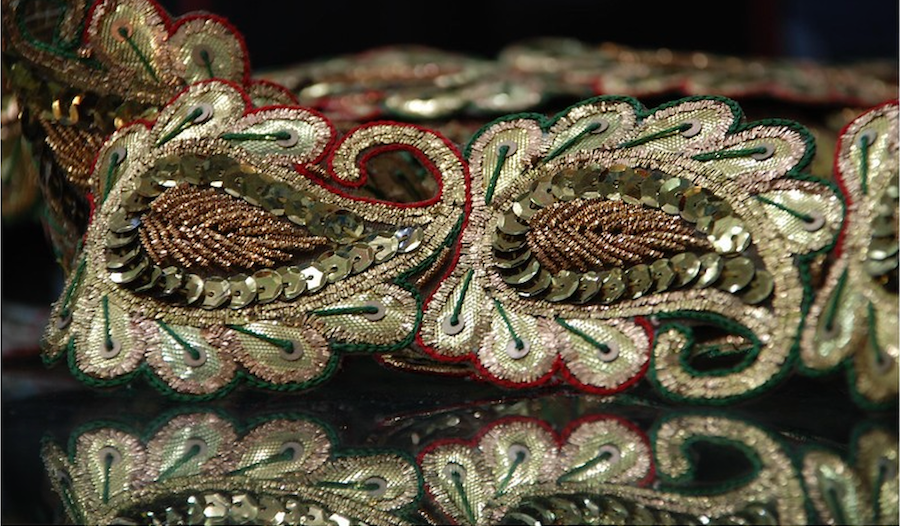
WEAVING ILLUSION
Image: Creative Commons
Text: Nidhi Garg Allen
The invention of gold wires did not only inspire jewellery makers and embroiderers. Weaving communities across India were equally excited by these lustrous metallic threads. In this final article, I want to share another gold technique, known as 'gota patti', or 'lappe ka kaam'.
At its simplest, gota is handwoven strips of gold or silver ribbon, created by weaving gold or silver wires on the warp and cotton or silk on the weft. Although, as we have learned, nowadays it is common for these pure gold or silver wires to be replaced by electroplated copper yarns or, for that matter, by synthetic yarns.
Gota can be woven in a variety of widths. While thin ribbons are called 'lappi', broad ribbons are known as 'lappa'. Various weaves can be employed, such as plain, twill, or satin. Skilled weavers may introduce shapes and designs, such as chevron, zig zag, or diamond.
Embossing is often used to add stylistic motifs on the surface of the gold or silver ribbon. A plain-woven ribbon (gota) is taken, and the designs are imprinted by passing the tape between two metallic rollers— one plain and one embossed —so that the pressure indents the design on the gota surface.
There are many ways these beautiful gold strips can be used to adorn the surface of a fabric; stitched to the edges as a lovely trim; or twisted, spiralled, and crimped to make beautiful motifs, flowers, or shapes.
Gota patti embroidery combines these gold strips with an embroidery technique almost identical to that of zardozi. 'Patti' is a Hindi word for leaf, and gota patti embroidery readily translates as gold leaf embroidery. In this technique, the gota is cut, and its edges folded into diamond-shaped leaves, which are pressed using a rolling pin. These leaves are then arranged and appliqued onto the surface of the fabric using various stitches to form flowers, birds, animals, and other motifs. The edge finishing can be done in many creative ways— perhaps with chain stitches using an aari needle, or with the spirals or coils of zardozi embroidery.

Image: Gota Patti collection by Goodearth, India
With machine-made synthetic or plastic ribbons readily available, it is undoubtedly less expensive to use this technique nowadays. However, the real beauty of gota work lies in authentic lappa or lappi, woven by hand, using pure materials. And the final beauty of gota is that the raw materials and designs can be removed from the surface of old textiles to be upcycled and reused.
 Image: Creative commons
Image: Creative commons
Nidhi Garg Allen is an alumnus of Parsons School of Design and Adjunct Professor at the Fashion Institute of Technology. A technologist turned artisan entrepreneur, she is the founder and CEO of Marasim. Marasim emerged from Nidhi’s curiosity for the history and beauty of her own Indian culture, with craftsmanship and textiles her medium of inquiry. Based in New York, Marasim is now committed to preserving artisanal textiles that use regional techniques, without uprooting craftspeople from their native communities. Marasim designs and develops high-quality products, in collaboration with traditional Indian artisans, for luxury designers, such as Gabriela Hearst, Tory Burch, Oscar de la Renta, and Bode.
